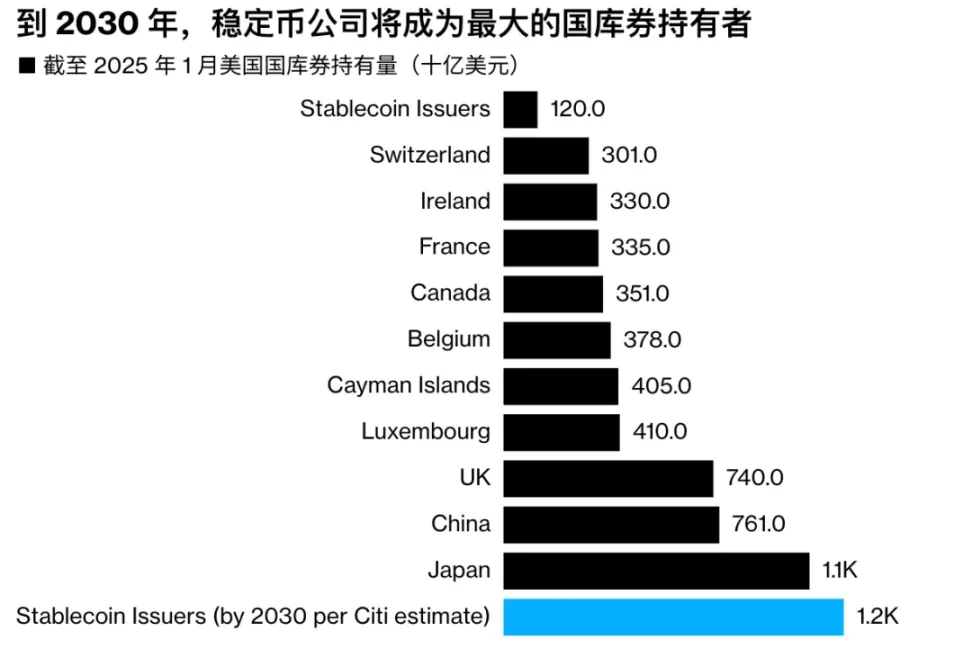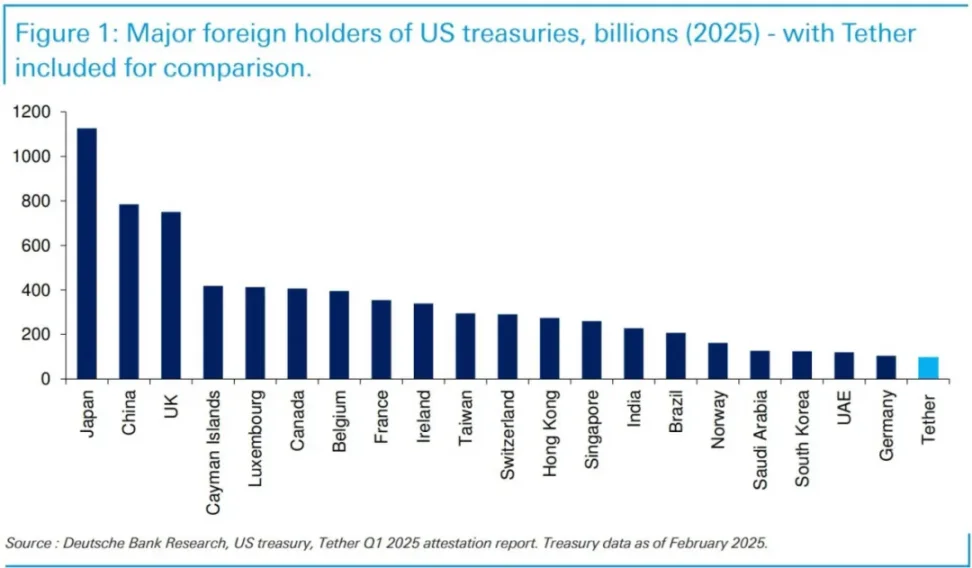From certain policy perspectives, "Tether's interests suddenly align with those of the United States."
Written by: Cobo Researcher
Stablecoin legislation is seen as a model for successful U.S. crypto regulation. However, in a larger narrative, it marks the beginning of a strategy to extend the dollar's influence.
With the "GENIUS Act" passing procedural votes in the Senate with overwhelming support on May 19, the U.S. stablecoin regulatory framework is accelerating towards implementation. This is not just a regulatory update but a national strategic deployment by the U.S. in the digital finance sector. In recent years, the U.S. government has quietly advanced a far-reaching financial strategy aimed at responding to the reshaping of the global financial landscape by regulating and guiding the stablecoin market, thereby consolidating the dollar's international dominance.
According to Bloomberg, this strategic consideration may be more profound than the market generally believes. As early as the Trump administration, there were signs that it had included the development of dollar stablecoins in national strategic considerations through executive means, using it as a tool to sustain dollar hegemony. The advancement of legislative frameworks like the "GENIUS Act" reflects the continuation of this thinking in the current administration. Treasury Secretary Scott Bessent recently pointed out in a congressional hearing that digital assets are expected to bring up to $2 trillion in new demand to the U.S. Treasury market over the next few years. This not only provides a new structural buyer for U.S. Treasuries but also extends the dollar's global influence digitally through mechanisms linked to stablecoins.
Stablecoin Legislation: A Policy Design for Strategic Gains
The core provisions of the "GENIUS Act," such as requiring stablecoin issuers to hold 100% of their reserves in cash or highly liquid assets like short-term U.S. Treasuries, along with monthly transparency reports, go beyond mere risk control. Such regulations will directly create structural demand for dollars and U.S. Treasuries. Theoretically, for every $1 of compliant stablecoin issued, an equivalent value of dollar assets is locked as reserves. Given that nearly 99% of stablecoins are pegged to the dollar globally, the scale effect of this mechanism should not be underestimated.
On one hand, this move introduces a new and growing group of buyers to the increasingly expanding U.S. Treasury market, especially in the context of traditional foreign sovereign buyers (like China and Japan) continuously reducing their holdings of U.S. Treasuries in recent years, highlighting its strategic value. On the other hand, by supporting a compliant dollar stablecoin ecosystem, the U.S. can maintain its monetary influence in the digital currency era without directly expanding the Federal Reserve's balance sheet.
The strategic value of this emerging capital flow for the U.S. Treasury market has been further confirmed by recent predictions from mainstream financial institutions. For example, Standard Chartered estimates that by the end of 2028, the circulating market value of stablecoins pegged to the dollar could soar eightfold to $2 trillion. Citigroup's analysis also depicts a similar growth trajectory, with its "base case" predicting that the market size will reach $1.6 trillion by 2030, and in a "bull case," this figure could even reach $3.7 trillion.

Source: U.S. Treasury, Tagus Capital, Citigroup
Crucially, both international banks have explicitly pointed out that since stablecoin issuers must purchase low-risk assets like U.S. Treasuries to support their token issuance, they are likely to surpass many sovereign nations in the scale of U.S. Treasury holdings in the coming years. The context of this trend is particularly noteworthy: on one hand, traditional major holders of U.S. Treasuries, such as China, have been continuously reducing their positions in recent years; on the other hand, policies like trade tariffs implemented during the Trump administration have at times sparked market scrutiny and questioning of the traditional safe-haven status of U.S. Treasuries. In this context, compliant stablecoin issuers are transforming from specific participants in the crypto space into potential, and possibly primary, sources of structural demand for U.S. Treasuries.
Tether's Role: From Market Giant to Strategic Hub
In this strategic landscape, Tether, the issuer of the world's largest stablecoin USDT, is playing an increasingly prominent role. Data shows that Tether's holdings of U.S. Treasuries are now comparable to those of major industrial countries like Germany. This positions Tether not only as a crucial infrastructure in the crypto market but also as a significant holder of U.S. Treasuries.

Tether's holdings of U.S. Treasuries are about to surpass Germany
Tether's uniqueness lies not only in its massive asset scale but also in its deep collaboration with the established financial institution Cantor Fitzgerald, a primary dealer and direct trading partner of the Federal Reserve, which provides Tether with unparalleled liquidity support in extreme market conditions. Through Cantor Fitzgerald, Tether can quickly sell its holdings of U.S. Treasuries for cash when users concentrate on redeeming USDT. For example, during the severe turmoil in the crypto market in 2022, USDT briefly depegged from the dollar, but Tether successfully managed $7 billion in redemption demands within 48 hours, accounting for 10% of its supply at that time. Such a scale of bank run would typically be enough to plunge most traditional financial institutions into crisis, but Tether weathered it smoothly, highlighting the robustness of its reserve system and the uniqueness of its liquidity arrangements.
To some extent, this institutional design aligns with the long-term goals of the U.S. to promote financial innovation and consolidate the dollar's dominance, resulting in a powerful stablecoin issuer deeply tied to the dollar, which objectively benefits the global penetration of the dollar system.
Global Expansion and the Soft Power Projection of Digital Dollars
Tether's ambitions do not stop at the existing market. The company is actively expanding its USDT business into emerging markets such as Africa and Latin America, and through diversified initiatives like acquiring local physical infrastructure, developing an asset tokenization platform called Hadron, launching a self-custody open-source wallet, and investing in brain-computer interfaces and peer-to-peer communication applications like Keet (based on the Holepunch protocol), it aims to build its so-called "AI Agent-driven peer-to-peer network." Its newly launched QVAC platform natively supports USDT and Bitcoin payments and integrates decentralized communication tools, aiming to create a digital ecosystem that emphasizes user autonomy, censorship resistance, and trustlessness.
Tether CEO Paolo Ardoino has mentioned observations regarding China's influence in developing countries through infrastructure projects and potential non-dollar payment systems (such as gold-backed digital currencies). In this context, Tether's layout in these regions can be seen as a market-driven business behavior aimed at promoting the use cases of dollar stablecoins, which also competes with other digital currency systems and expands the dollar's influence in the digital realm. This aligns to some extent with the U.S. macro strategy of maintaining its global currency status.
Despite its prominent market position and unique liquidity mechanisms, Tether's operations are not without controversy. According to a report by The Wall Street Journal last October, federal prosecutors in Manhattan investigated potential violations of sanctions and anti-money laundering regulations by Tether (Tether stated it was unaware of this or was cooperating with law enforcement). In 2021, Tether paid $41 million to settle with U.S. regulators over allegations of misreporting reserves. These historical events and ongoing scrutiny highlight the challenges faced by large stablecoin issuers in compliance and transparency. CEO Ardoino himself only visited the U.S. for the first time in March of this year, joking that he might have been arrested if he had come earlier, reflecting the subtlety of Tether's relationship with U.S. authorities. However, Bloomberg's report also pointed out that from certain policy perspectives, "Tether's interests suddenly align with those of the United States."
A New Path for Dollar Hegemony in the Digital Age
The U.S. strategy of regulating and guiding the stablecoin market through legislative tools like the "GENIUS Act," combined with the rise and global expansion of market players like Tether, is paving a new path for consolidating the dollar's international status. This not only brings significant new demand for U.S. Treasuries, but Standard Chartered analysts even believe that the industry’s purchases of U.S. Treasuries over the next four years "could roughly cover all possible additional U.S. Treasuries issued," alleviating the pressure from traditional buyers reducing their holdings. Moreover, in the wave of global digital transformation, it maintains and extends the dollar's global influence in a relatively low-cost and more penetrating manner. As Treasury Secretary Bessent acknowledged, digital assets could bring $2 trillion in new demand for U.S. Treasuries in the coming years, but the expansion of stablecoins also brings risks, such as any sudden surge in redemption volumes that could force operators to quickly liquidate their Treasury positions, potentially disrupting the market. Additionally, with traditional financial giants like PayPal and new players like World Liberty Financial, linked to the Trump family, entering the market, the competitive landscape is also evolving. However, the long-term effectiveness of this "open conspiracy" will still unfold under the multiple tests of global regulatory coordination, technological security, geopolitical competition, and market competition.
Reference link: https://www.bloomberg.com/news/articles/2025-05-13/tether-s-150-billion-managed-by-unknown-brit-in-the-bahamas-usdt
免责声明:本文章仅代表作者个人观点,不代表本平台的立场和观点。本文章仅供信息分享,不构成对任何人的任何投资建议。用户与作者之间的任何争议,与本平台无关。如网页中刊载的文章或图片涉及侵权,请提供相关的权利证明和身份证明发送邮件到support@aicoin.com,本平台相关工作人员将会进行核查。




